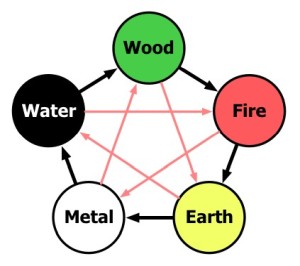The Five Elements
 In line with its origins in Taoism, Chinese Medical theory is based on the observation of nature. Taoist thought suggests there are five naturally occurring elements. These elements are said to give rise to all natural phenomena. These are earth, fire, wood, metal and water. Chinese Medicine uses the notion of these elements within its systems of diagnosis and treatment. As a side note, you may notice the omission of air (which is features in the Ayurveda tradition).
In line with its origins in Taoism, Chinese Medical theory is based on the observation of nature. Taoist thought suggests there are five naturally occurring elements. These elements are said to give rise to all natural phenomena. These are earth, fire, wood, metal and water. Chinese Medicine uses the notion of these elements within its systems of diagnosis and treatment. As a side note, you may notice the omission of air (which is features in the Ayurveda tradition).
Each element has its own characterises and identity. Everything in the natural environment is said to pertain to one of the elements. Thus, in turn began the formulation of a system of classification in which natural phenomena have been assigned to one of the elements. This is true for directions, colours, seasons, climates, numbers, planets, animals, tastes grain etc.
Within Chinese Medicine, each of the elements was assigned aspects of bodily physiology and anatomy. Each element has been assigned with: a yin organ; a yang organ; an emotion; a sense organ; a bodily tissue; and even a vocal sound.
A key characteristic of the theory is its cyclical nature. Each element assist in generating the conditions necessary for the next. This is said to occur in a set order of earth, fire, earth, metal then water. For the body to be in a state of good health, qi (energy) will flow from one element to the next in this set order. When the body is out of balance, or in a state of disease, the energy will move from one element to another in disregard to the sequence.




